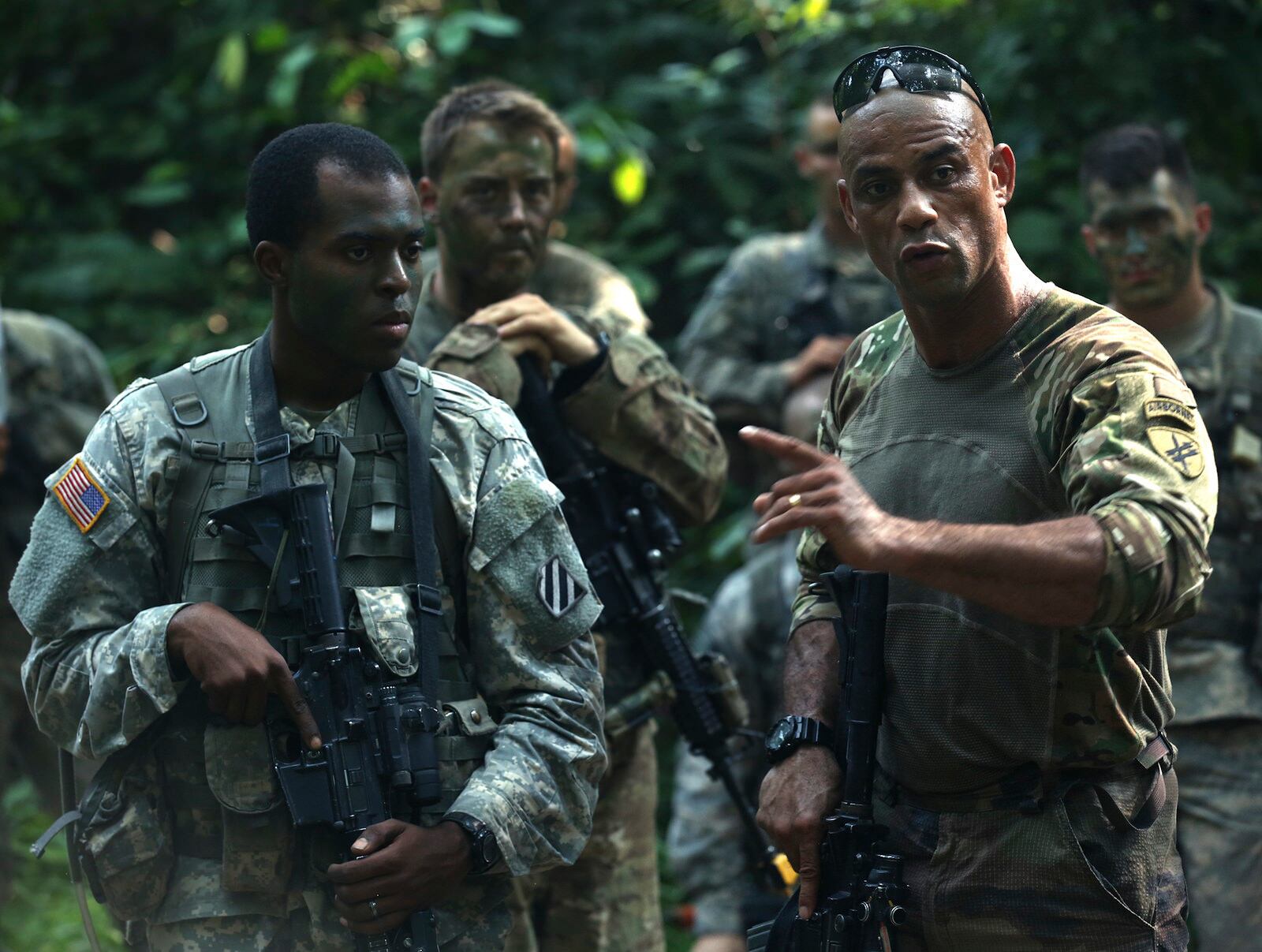LIBREVILLE, Gabon – When Pfc. Michael Ksander arrived at the French Jungle Warfare School here, he had no idea what to expect.
"The swamps of Georgia are very different than the jungle here, incredibly different," said Ksander. "I thought it would be similar to the environment you might see in Florida, maybe New Orleans or Georgia, but it's not."
Ksander and about 80 of his fellow infantrymen from 3rd Battalion, 7th Infantry Regiment this month became the first American service members to attend the school here. The soldiers, from Fort Stewart, Georgia's 2nd Brigade Combat Team, 3rd Infantry Division, battled heat, humidity, wildlife and rugged terrain under the watchful eye of French instructors as well as noncommissioned officers from the Army's Jungle Operations Training Course, run by the 25th Infantry Division, in Hawaii.
After completing jungle training, the soldiers stayed on in Gabon for Central Accord, an annual exercise that brings together partner nations from Central Africa to train and practice conducting peacekeeping operations.
Capt. Zachary Schaeffer, the commander of B Company, 3rd Battalion, 7th Infantry Regiment, said the jungles of Gabon are nothing like he nor his soldiers had ever seen.
"In the past couple months, 3-7's dealt with the swamps at Fort Polk, we've been to Fort Irwin and Fort Bliss working through the desert, and, of course, we train at Fort Stewart," he said. "But we've never really encountered the jungle and humidity we have here on the equator in Gabon."
The Army as a whole has lost much of its ability and knowledge base for operating in the jungle, especially as the force bore the brunt of back-to-back deployments to Iraq and Afghanistan.

A jungle school instructor explains squad movement to U.S. soldiers assigned to Bravo Company, 3rd Battalion, 7th Infantry Regiment, 2nd Infantry Brigade Combat Team 3rd Infantry Division at the Jungle Warfare School near Yemen, Gabon, on June 9.
Photo Credit: Sgt. Henrique Luiz de Holleben/Army
The 25th Infantry Division in 2014 launched its Jungle Operations Training Course to better prepare for its regional alignment with Pacific Command and the Defense Department's rebalance toward the Asia-Pacific region.
Standing up the school in Hawaii marked the first time the Army had its own jungle school since Fort Sherman was turned over to the Panamanians in 1999.
The jungle training area here in Gabon was only about 4 kilometers in size, but with the dense forest, the soldiers had enough to worry about, Schaeffer said.
"There are a lot of challenges in the jungle, whether it's the dense vegetation or the wildlife, from snakes to chimpanzees, all of which we encountered while we were out there," he said.
The soldiers also had to adapt to the dense jungle, "where you can only see 5 to 10 meters in front of you," he said.

A U.S soldier lights a fire using a flint and gauze at the French Jungle Warfare School near Yemen, Gabon, on June 6.
Photo Credit: Yvette Zabala-Garriga/Army
"Whether you're just sweating or whether it's raining or you're neck-deep in water, you're constantly wet, and the humidity doesn't help with that," Schaeffer said. "Your clothes never dry out, which is something we're not typically used to."
His soldiers persevered, Schaeffer said, and in turn learned how to fight in a "unique" environment.
"The jungle's not what I expected," he said. "It's so much harder than it seems, especially when you add your rucksack and your weapon."
For Sgt. Jesse Harlan, this wasn't his first time in the jungle. The team leader in B Company attended the Jungle Operations Training Center in Hawaii and got some jungle training during a Pacific Pathways rotation through Malaysia.
"Some of the challenges are just going to be the environment," he said. "The brush is a lot thicker, it gets darker a lot faster. You may only move 100 meters a day, and you're carrying a lot of your gear, and you've got to deal with a lot more of the elements."
A highlight from a weeklong training was the obstacle course, Harlan said.
"It was real fun to get the guys to work together, getting in the water, getting wet, carrying a sandbag on your back," he said.
Harlan also learned that you don't shave in the jungle for fear of infections, and to bring many, many pairs of socks.
He also learned to put together a dry kit of clothes, he said.
Ksander said he was surprised at how difficult it is to move in the jungle.
"It's so much more confining, the way you move through the jungle," he said. "Everything's so much more detectable. Everything's louder in the jungle. Everything is in your face, and it seems like anything can touch you at the same time."
He learned about booby traps, building shelters and building fires.
"Moving is hard, doing the simple things are harder," Ksander said about the jungle. "Everything's loud, every step you take feels like everybody for miles can hear you."
As for what he learned?
"I really appreciate coffee more than I ever have, and [air-conditioning], and clean bathrooms," he said.
Michelle Tan is the editor of Army Times and Air Force Times. She has covered the military for Military Times since 2005, and has embedded with U.S. troops in Iraq, Afghanistan, Kuwait, Haiti, Gabon and the Horn of Africa.





